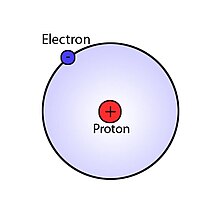Bohr radius
| Symbol | a0 or rBohr |
|---|---|
| Named after | Niels Bohr |
| Approximate values (to three significant digits) | |
| SI units | 5.29×10−11 m (52.9 pm)[1] |

The Bohr radius (denoted as a0) is a concept from Bohr's atomic model of 1913. Bohr's model says that an atom is made of a core, called nucleus. A number of charged particles orbit the core.
Named after Niels Bohr, the Bohr radius has an approximate value of 5.29177210544 × 10-11 meters. In the Bohr model, electrons orbit the nucleus at discrete energy levels, and this radius defines the smallest possible orbit with the lowest energy for a hydrogen atom. Bohr took the simplest possible atom, hydrogen, at the state with the lowest possible energy. He says that the Bohr radius is the distance between the nucleus, and its first electron shell.
In Hydrogen, a single electron orbits the nucleus. Hydrogen has an orbital radius which is almost equal to the Bohr radius. Because of the reduced mass effect, the actual radius is different from the Bohr radius. The difference is about 0.05 %. With Helium, the difference is 0.01%. This difference comes from the fact that Bohr's model does not take into account that the nucleus moves as well.
In 1926, Erwin Schrödinger proposed a new model. This model is more advanced and uses the Schrödinger equation. It relies much more on probabilities. Unfortunately, the model is also more complex than Bohr's model.
Because Bohr's model is much simpler, it is still used in some cases. The Bohr radius has become a unit of length.
In an essay, Niels Bohr mentions Austrian physicist Arthur Erich Haas, who found the formula to calculate the radius, in 1910.[2] Haas is credited with the discovering the role of Planck's constant for physics.
The Bohr radius is a physical constant. It is about 52,9 picometres, or half an Angstrom. Atom physics uses it as a unit of length.
References
[change | change source]- ↑ "2022 CODATA Value: Bohr radius". The NIST Reference on Constants, Units, and Uncertainty. NIST. May 2024. Retrieved 2024-05-18.
- ↑ N. Bohr (1913), "On the Constitution of Atoms and Molecules", Philosophical Magazine (in German), vol. 26, p. 4
